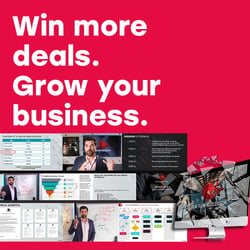Tactics for Upselling and Cross-Selling to Your Current B2B Customers
Are you doing enough to achieve and surpass your revenue goals? If you are not marketing additional products or services to your existing B2B customers, you are missing out on an opportunity to increase your revenue. Some sales managers think the most vital aspect of sales in the B2B realm is generating new leads. But they are wrong. While looking for more leads is essential, looking after your existing clients is far more important.
Forbes claims that the likelihood of selling to a new prospect is approximately 5-20%, while the probability of selling to an existing customer is between 60-70%. This is because your current B2B customers already know your business and trust your products or services. Plus, you have a better understanding of their needs, so you have a better chance to provide what they exactly need.
It is easier to continue an existing relationship than build a new one. Also, maintaining your existing customers will cost you less than looking for new customers. But how do you maximize your revenue, improve brand loyalty and retain B2B customers? Upselling and cross-selling is the answer! However, you must use upselling and cross-selling strategies the right way to improve customer experience.
Upselling and Cross-Selling Explained
Cross-selling is a strategy where you recommend additional products to a customer to increase their average order value. For example, when a customer adds a phone to their cart, the company can recommend screen protectors and phone cases in an attempt to cross-sell related products at the point of sale.
You can also offer a bundle; parceling up several related items and offer them as one package. Then provide incentives like lowering the overall average price and offering free shipping. Customers always love to feel they have gotten a better bargain. Someone who was initially looking for one product is more likely to switch to the bundle.
On the other hand, upselling means offering B2B customers improved, higher-end products compared to their previous purchases. This strategy is popular in the mobile market, SaaS business, and E-commerce storefronts. For example, if a customer adds an Apple iPhone 11 to their cart, the company may suggest upgrading to Apple iPhone 11 Pro Max as a part of their upselling campaign.
How to Upsell and Cross-Sell to Your B2B Customers Effectively
Below are the most efficient tactics for upselling and cross-selling to your existing B2B customers:
Understand Your Customers Well
Having an in-depth understanding of your B2B customers is very important, especially in upselling and cross-selling. This is because the relevance of products you recommend to customers will determine if they will buy the products or not. You have to research which products can have the most significant impact on your customers and be ready to prove their value to the customer. You must think of how upselling and cross-selling can add value to your clients and their business.
Using both qualitative and quantitative data, you can build ideal profiles for your existing B2B customers. Thanks to technology, it's effortless to collect your existing customers' data. Look out for clients' feedback, reviews, and experiences at each point of their buyer journey. When you find a good customer review, then that is your chance for upselling and cross-selling.
Customers always love a bit of personalization. It makes them feel happy your company has taken their time to know more about them and their preferences. Find out how they like to be addressed by name or title and the optimum time of the day to contact your customers. It is good to train the customer service team to spot an opportunity for cross-selling and upselling. Developing their listening skills will help them identify additional sales opportunities and pass this information to the sales team.
Know Your Products Inside Out
It's no use knowing your customers if you do not understand what you are selling to them. It will be difficult for customers to agree to additional sales without finding out more about the products. So, you need to be ready to answer customer questions confidently.
For example, let's say you intend to upgrade a customer from a basic software package to a more advanced package. Do you think the customer will want the more advanced package if you cannot tell them about its features? You need to ensure your employees understand your products. Educating them on all the products and services you offer is very crucial.
Knowledgeable customers will research before agreeing on your upgrade suggestions or add-ons, so they will find out if you are offering them something worthy. Using your product knowledge, you can explain how an upsell or cross-sell product can satisfy their needs. Having in-depth knowledge about the products you sell will ensure an upsell or cross-sell opportunity will not bypass you.

Use the Right Sales and Data Tracking Software
Successful upselling and cross-selling for B2B depend on the right tools as well as the right people. Investing in the right software will help you keep track of who visits your website and interact with your clients effectively. Automating some sales aspects will help improve your relations with customers. For example, using data monitoring tools will give you insights to help personalize customer interactions.
Using software that classifies and tags related products makes cross-selling and upselling easier, like introducing a ''other clients also bought'' feature. Also, analytics tools will help identify which products you should offer to which customer, leading to successful upselling and cross-selling. The right software will also help sales representatives know when to upsell and cross-sell to each customer.
Don't Be Annoying!
Nothing is more off-putting to customers than an overly persistent salesperson. Listen to your customers. Assessing the best opportunity to recommend additional products or a better product to customers can be challenging. But after you get to know your customers well, you will find it easy.
Avoid being too pushy. If the customer seems distorted, stressed, or in a rush, pull back and wait for the next contact. You will most likely get another opportunity. If you handle your customers the right way, they will definitely purchase what you recommend. First, ensure what you are offering complements the initial product or service and is helpful to the client. If it's not relevant, the client will think you are just selling for the sake of selling.
Also, keep in mind the client's budget and do not recommend add-ons or upgrades that are way too far over it. Make sure the overall order does not increase by more than 25%. Also, ensure the customer knows the prices to avoid a shock at checkout and possible desertion of the products.
Follow Up with Emails
Maintaining communication with your current B2B clients after-sale is essential. It presents more opportunities for cross-selling and upselling. Send follow-up emails thanking customers for buying from you and find if they are happy with the products they selected. You can reward them with discounts and special offers for giving their feedback, and encourage them to recommend their friends. In addition, you can provide loyalty points to encourage further business interactions.
If they did not buy what you offered, send follow-up emails to remind them what they are missing. Ensure your messages have a sense of urgency but do not overdo. Offering a slight reduction of prices on your products and services can bring back your existing clients to do more business with you.
Use the Right Words
For successful upselling and reselling, customers must feel they are getting value from the products you recommend for upgrades or add-ons. You need to communicate with customers using the correct phrases like ''special offers'' or ''Save now'' to tap their innate desire to get a good deal. Customers are more likely to buy additional products or a better version of products when they feel they are getting the best deals.
Bottom Line
Upselling and cross-selling are some of the most effective strategies to help you close more deals with your existing clients. However, you need to put effort into achieving that. Knowing your customers and your products can help you reap the rewards from upselling and cross-selling. Also, it will be best if you use the right words to make your customers get interested in buying the recommended add-ons and upgrades.
Also, it's worth noting incentivization and personalization go a long way in keeping your existing customers happy. Try offering discounts and free trials on products you know your customers will love. Use the latest technology to improve customer experience. Lastly, avoid being overly pushy; it can affect the customers' perception of your brand. Remember, the goal is to offer products and services that bring value to customers, not make them buy items they do not need.
Wouldn't you want to keep your prevailing B2B customers and close more deals? Contact us today to point you in the right direction.
Even better, join Deal Flow Accelerator today, our expertly designed sales training program, to learn how to maintain your loyal B2B customer base while growing your business through upselling and cross-selling.
You May Also Like
These Related Articles

B2B Sales Tips: Effective Tactics You Can Use to Close More Deals

How to Dominate in B2B Sales: 9 Tips You Should be Aware of




